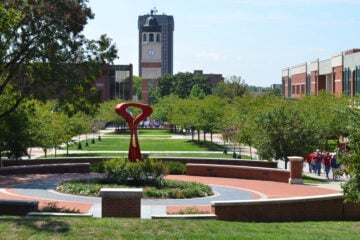How public radio’s structure, growing resources are giving local journalism a boost

wildpixel / iStock
In a four-part series, the co-authors of “The Growing Strength of Public Media Local Journalism” have excerpted their findings for the Current readership. In the report, the co-authors make the case for why public media stations are well positioned to play a meaningful role in efforts to rebuild local news. You can find the full report, including an introduction, methodology and report background, here. This research was made possible through the generous support of the Wyncote Foundation, for which we are grateful.
The strength of the public radio audience
It is easy to overlook or underestimate the size of NPR member stations’ audience reach. NPR’s most recent estimate for its total weekly audience was 53 million audience members in fall 2021. (This represents a slight decline from spring and fall 2020 — which saw a jump to 60 million during the beginning of the COVID-19 pandemic and a U.S. presidential election — but an overall increase from 2016 through 2019.)1
Part of NPR and NPR stations’ popularity stems from the popularity of commuting-time listening. In May 2022, NPR-affiliated stations were the No. 1 news stations during morning and/or evening drive times in 31 of the top 50 media markets, based on Average Quarter Hour (AQH, or the number of people listening within a 15-minute period) among those ages 25 to 54. Furthermore, NPR-affiliated stations were the No. 1 news stations during morning and/or evening drive times in the top 10 media markets. In fall 2021, All Things Considered reached 11.4 million people each week, and Morning Edition reached 11.8 million, according to Nielsen Audio metrics. The next largest audience for a non-NPR news radio program, The Sean Hannity Show, clocked in at less than half that size with an audience of just over 5 million in fall 2021.2
Focusing on broadcast audiences, we find that the audience for public radio is both large and stable. For the past decade, the weekly audience for public stations has held steady at roughly 30 million listeners, according to data provided by Station Resource Group, which performed this analysis using Nielsen Audio data. NPR estimates that in fall 2021, the weekly audience for all of public radio was 35.8 million. Looking specifically at the weekly broadcast audience numbers for NPR member stations, the total for 2021 came to 33 million. In 2011, that number was more than 34 million, and in 2001, that number was more than 25 million.
NPR assesses its broadcast weekly audience by combining NPR-distributed programming and newscasts. Between fall 2016 and spring 2021, NPR’s smallest audience was 23 million per week in spring 2020, and its highest audience was 30 million per week in spring 2016 through fall 2017. Fall 2021 saw NPR’s total audience fall to 25 million per week. These fluctuations may reflect broader changes in news consumption during and after the U.S. presidential election cycle in 2016, as well as the pandemic-induced reduction in commuter times.
Many local stations enjoy dedicated broadcast listenership. On average, a core listener to a station tunes in 18 times a week.3 Annual listener hours in 2020 total well above 3.4 billion.4 In the five years between 2016 and 2020, the peak was close to 3.9 billion in 2017. As referenced above, many public radio stations now rank first in their broadcast markets. According to data provided by the Radio Research Consortium (RRC), the public radio stations in San Francisco, Boston, Portland, Seattle, Raleigh, N.C., and Washington, D.C., rank No. 1 in their markets.
According to data provided by Audience Research Analysis (ARA), the three stations in fall 2021 with the largest weekly cumulative audiences were WNYC in New York with about 822,000 listeners each week, KQED in San Francisco with about 698,000 listeners each week, and KPCC in Los Angeles with about 682,000 listeners each week. In fall 2021, the top three stations in average quarter-hour listening were in New York, with an AQH of 26,600 people, followed by San Francisco with 23,300 and Chicago with 21,800. In fall 2021, the top three stations by “loyalty” — the percentage of a station’s audience’s time listening to radio that is spent with the station — were KSKA in Anchorage, Alaska, followed by WEKU in Lexington-Fayette, Ky., and KCUR in Kansas City, Mo.
Establishing the cumulative local digital audience of public media licensees is very difficult. The closest estimate we can assemble is the number of weekly website unique users of NPR member station websites. NPR audience analytics reports that between 2015 and 2021 that number remained largely stable at about 5 million. During the early days of the pandemic that number rose above 15 million and slowly declined back to about 5 million.
Explaining public media local journalism’s evolution and expansion
What accounts for the growth of public media local journalism among public radio stations? This is a key question for policymakers, funders, and industry leaders looking to rebuild local news. We attribute the growth of public media local journalism to three fundamental related features of the public media system: organizational sophistication and maturity, the federated structure of public media, and the resulting financial strength of the system as a whole.
Organizational sophistication and maturity. One key driver of the sustained expansion in local journalism capacity and local public service is the increasing sophistication and maturity of public media organizations, especially among the largest stations. Leading public media stations have invested in developing efficacy across key organizational components. Investment in strengthening editorial, formal human resources capacity, product development capability, marketing and sales expertise, development muscle, and editorial strength have each been critical to the strongest stations’ growth in local journalism.
These components of organizational sophistication and maturity have allowed stations to develop benchmarking tools and improve business and content practices across their products. The stability and financial capacity of public media news organizations has attracted experienced talent from print and mainstream broadcast news.
We have seen a positive feedback loop at work in licensees that have invested in their organizational capacity. The expansion of corporate support staffing capability and the development of networked back-office operations have created additional bandwidth and expertise, which are fueling the next stage of organizational growth and service in the largest licensees.
It is important to note that the organizational practices around development and underwriting have become particularly sophisticated in large licensees. Development practices that now target upgrading donors, expanding corporate support sales, and in some cases building endowments have all supported expanded newsrooms.
The organizational strength and sophistication of the largest licensees have also allowed them to pursue resource efficiencies and to be able to house multiple media services under one administrative apparatus. For example, Louisville Public Media has a classical music radio service, a news/talk service, and an adult alternative music service, as well as an investigative reporting center, all under a single operating organization. This kind of arrangement allows a public broadcaster to maximize revenues and service while sharing costs.
The culture and leadership of large public broadcasters have also undergone a growth spurt. As these organizations have matured, their leaders have come together to engage in more advanced station-level and industry-level planning. This includes ambitious cross-industry coordinated audience growth efforts like the Station Resource Group’s 2010–2011 effort to grow the public media audience.
The federated structure of public media. The federated structure has created an underlying buffer against organizational decay — allowing licensees to mature and embark on individual developmental paths. Licensee boards tend to be robust and well-developed with strong links to other community institutions. Licensees, as a result, have a remarkable longevity, despite many of them outgrowing their founding educational and cultural mandates. For example, NPR launched with 88 member licensees in 1970, and as of 2022 there are 250. These NPR members own and operate more than 1,000 station signals nationwide, as of fall 2021.5
Increased resources and business model sustainability. Our analysis leads us to believe that the result of growing organizational sophistication, buttressed by the federated structure of public media, has been an increase in resources and sustainability for individual licensees and the public media system as a whole. Mature stations in major media markets in particular have grown dramatically over the last five decades, especially compared to other local media outlets. This is remarkable given the overall corporatization and digitization of media and shrinking of commercial local news media during the same time period.
All of these factors combine to explain the central observation that attracted our attention: namely, news-focused licensees and the stations they control appear to be expanding their local journalism capacity during a period when other sectors of the local journalism industry were contracting. Especially among the larger public radio licensees, the maturity of their organizations, the increasing sophistication of their leadership and the strength of their revenues have provided a strong, stable foundation that these organizations are using to continue their role as NPR affiliates for national news and, now, to expand their role of providing original local news content within local markets.
Thank you for reading! Stay tuned for the final installment of this series, to be published Thursday, about the caveats and takeaways of these findings for public media local journalism.
Elizabeth Hansen Shapiro is CEO of the National Trust for Local News. From 2020–22, she was a Senior Research Fellow at the Tow Center for Digital Journalism at Columbia Journalism School. Previously, Elizabeth led news sustainability research at the Shorenstein Center on Media, Politics, and Public Policy at the Harvard Kennedy School. She was the Research Director for the Membership Puzzle Project’s Guide to Membership and the Public Media Mergers Project. She received her Ph.D. in Organizational Behavior from Harvard Business School.
Mark Fuerst is founder of Innovation4Media (I4M), which has worked with public media stations, networks and association leaders to understand the public service and business opportunities of digital media. Since 2012, Mark has managed the Wyncote Foundation-supported Public Media Futures Project, to study the changing media landscape. He was co-founder and Executive Director of the Integrated Media Association (IMA). From 1986 to 1997, Mark was General Manager of WXPN-FM in Philadelphia, the station that developed the AAA music format for public radio. He was co-creator and executive producer of World Café, NPR’s AAA music program that airs on 581 stations.
Caroline Porter is a media strategist and researcher. She serves as Director of Impact and Strategic Partnerships at the National Trust for Local News. Caroline worked as a staff reporter for The Wall Street Journal in the Chicago and Los Angeles bureaus and served as an adjunct lecturer at Northwestern University’s Medill School. As a Fulbright Scholar in Northern Ireland, Caroline researched the role of media in the post-conflict region and earned a master’s degree with honors from Ulster University. You can find her on Twitter at @carolineporter.






